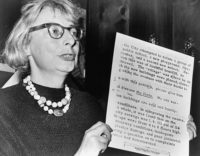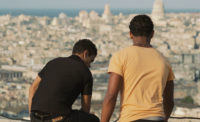By day the CEO of design and brand strategy firm Bassett & Partners, Tom Bassett moonlights as an occasional filmmaker. His first film, the 18-minute Connecting released in 2012, was co-produced by Microsoft Design and focused on the “Internet of Things.” His latest work is more ambitious. Briefly, a 26-minute film released for free online last month that explores how some uber-creatives work with, bend, manipulate, and subvert the document that kicks it all off—the project brief—to accomplish great end products. “We basically write creative briefs for a living, for design clients and for brand and advertising and marketing clients,” Bassett says. “So we were just curious what we could learn from a broad range of creative folks about how the brief is used by people who manage to arrive at exceptional creative results”
The lineup Bassett assembled for his project is impressive: Architects Frank Gehry and David Rockwell; John Boiler, CEO of 72andSunny; John C. Jay, Global Co-Executive Director of Wieden+Kennedy; industrial designer Yves Behar; and author and illustrator Maira Kalman. Each subject speaks about their experience with one specific project, how it was presented to them in the brief, and the ways in which they arrived at unique results (or didn’t) given the constraints of the project’s foundational document. RECORD spoke with Bassett about why he made the film, what he learned about these creative people while interviewing them, and what he hopes will come out of this project.
How many people and briefs did you start with before you ended up on the final six represented in the film?
Our goal was to have a range of creative disciplines represented. We wanted people who had been doing it consistently for a long time, not someone who had a one-off and did something great. And then the last metric was, Who could we actually get to? Who do we know? Who do we have relationships with? Because you can't just call up Frank Gehry and say, "I have an idea for a movie." And he's, like, "Sure!"
Did you struggle to convince them to be part of this?
No, actually, I was really happy about how receptive they were. I think it helped that we weren't using it as a tool to make money for ourselves, but as a way to inspire future generations of creative collaborators, including students. The people in the film are at a stage where mentoring is part of their whole deal. They were very welcoming and warm and kind and generous with their time. Lots of people, I'm sure, are trying to profit off of them in some way, and the fact that we were just releasing it online for free was our way of giving back, so they identified with it.
Why release the film that way?
We're not film people, for one, so the goal wasn't necessarily to say, "Hey, let's launch a film! Let's make money. Let's get on the film festival circuit." We're a design and brand strategy firm. And if you look at the history of technology, and there's debate about this, but generally speaking open systems win, right? So we felt like if we open this up, hopefully more products, services, brands, advertising, and creative projects will be better—if more people are better informed about how to use the brief to arrive at exceptional creative places.
The six people featured, for the most part, speak about one specific project. Did you have to tease that out of them, or did they have a project they wanted to focus on?
Not at all. We just said, we're going to interview you about this, and they agreed. I don't think they thought it was going to be that interesting a film to start with. "Oh, a film about the brief?" That's not exactly Gone Girl, you know? And so we just sat down with them and the interview structure was basically: What is a brief? How do you define it? Obviously it's a piece of paper or a document or a meeting, but there are higher-order, conceptual ways that you think about what a brief is. In the early stages of the film Frank Gehry says it's a clarity of purpose, or John Boiler says it's an open statement of ambition for a brand. And then we asked, what makes for a great brief and what makes for a bad brief? We asked them to share stories where the brief played a really central role, or not. Then the last section was, what advice would you give future generations or younger people coming up in the industry about the brief and how to use it to get to great creative places? So we didn't know what stories they were going to share.
Were you ever tempted to look at this on a larger, feature scale?
We'd love to. Our point of view going in was, first of all, it's about the brief, so probably it shouldn't be long. And our feeling was that the film would be as long as the story held together. Just because you can build a 300-story building doesn't mean you should. And so we felt like that length and the way it was constructed, that hung together well as a film. I have heard from a number of people that they felt like they got to the end of the film and thought, "Wow, I could have kept watching. You didn't lose me yet." So, what I think we'll probably end up doing is more of a series.
Would you ever take any of the footage that didn't make it into the film and put that online as well?
Yeah, that's absolutely going to be how we continue this. We have a videos tab [on the website], and we've populated it with a few outtakes already. To be honest with you, I was a bit naive thinking I could interview six famous people and put them in one film. Editing that was hell because they're all brilliant and they each could have had their own film about them and the brief. So as we got into the edit it was just massively stressful as a director to think about, okay, I've got to give them equal airtime. How do we balance this and make them all feel included? So we have all this amazing material. Again, as a teaching and inspirational tool, hopefully architecture students [use the material] to accelerate their learning as it relates to how to think about the brief, how to use the brief in terms of getting to great creative places and not just executing orders.










Post a comment to this article
Report Abusive Comment